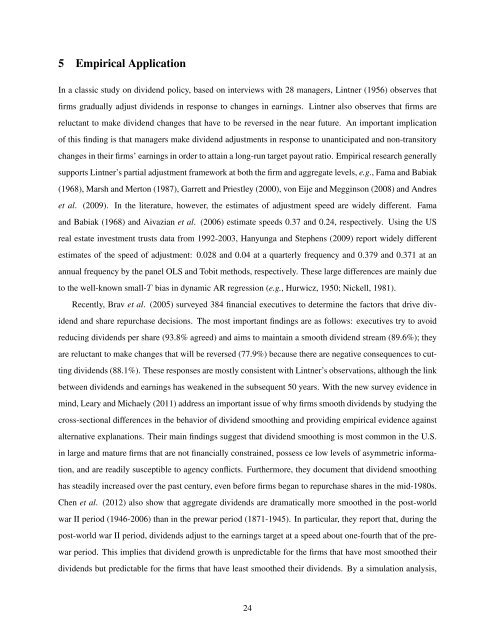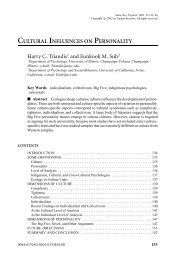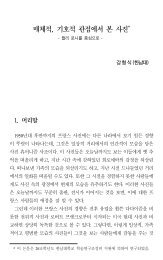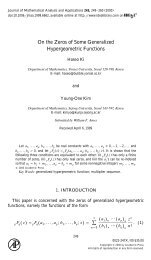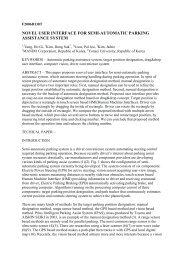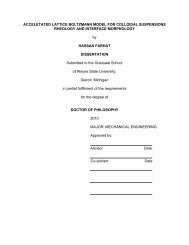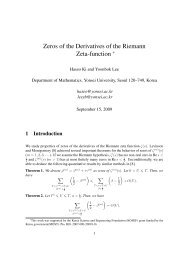Quantile Cointegration in the Autoregressive Distributed-Lag ...
Quantile Cointegration in the Autoregressive Distributed-Lag ...
Quantile Cointegration in the Autoregressive Distributed-Lag ...
Create successful ePaper yourself
Turn your PDF publications into a flip-book with our unique Google optimized e-Paper software.
5 Empirical Application<br />
In a classic study on dividend policy, based on <strong>in</strong>terviews with 28 managers, L<strong>in</strong>tner (1956) observes that<br />
firms gradually adjust dividends <strong>in</strong> response to changes <strong>in</strong> earn<strong>in</strong>gs. L<strong>in</strong>tner also observes that firms are<br />
reluctant to make dividend changes that have to be reversed <strong>in</strong> <strong>the</strong> near future. An important implication<br />
of this f<strong>in</strong>d<strong>in</strong>g is that managers make dividend adjustments <strong>in</strong> response to unanticipated and non-transitory<br />
changes <strong>in</strong> <strong>the</strong>ir firms’ earn<strong>in</strong>gs <strong>in</strong> order to atta<strong>in</strong> a long-run target payout ratio. Empirical research generally<br />
supports L<strong>in</strong>tner’s partial adjustment framework at both <strong>the</strong> firm and aggregate levels, e.g., Fama and Babiak<br />
(1968), Marsh and Merton (1987), Garrett and Priestley (2000), von Eije and Megg<strong>in</strong>son (2008) and Andres<br />
et al. (2009). In <strong>the</strong> literature, however, <strong>the</strong> estimates of adjustment speed are widely different. Fama<br />
and Babiak (1968) and Aivazian et al. (2006) estimate speeds 0.37 and 0.24, respectively. Us<strong>in</strong>g <strong>the</strong> US<br />
real estate <strong>in</strong>vestment trusts data from 1992-2003, Hanyunga and Stephens (2009) report widely different<br />
estimates of <strong>the</strong> speed of adjustment: 0.028 and 0.04 at a quarterly frequency and 0.379 and 0.371 at an<br />
annual frequency by <strong>the</strong> panel OLS and Tobit methods, respectively. These large differences are ma<strong>in</strong>ly due<br />
to <strong>the</strong> well-known small-T bias <strong>in</strong> dynamic AR regression (e.g., Hurwicz, 1950; Nickell, 1981).<br />
Recently, Brav et al. (2005) surveyed 384 f<strong>in</strong>ancial executives to determ<strong>in</strong>e <strong>the</strong> factors that drive dividend<br />
and share repurchase decisions. The most important f<strong>in</strong>d<strong>in</strong>gs are as follows: executives try to avoid<br />
reduc<strong>in</strong>g dividends per share (93.8% agreed) and aims to ma<strong>in</strong>ta<strong>in</strong> a smooth dividend stream (89.6%); <strong>the</strong>y<br />
are reluctant to make changes that will be reversed (77.9%) because <strong>the</strong>re are negative consequences to cutt<strong>in</strong>g<br />
dividends (88.1%). These responses are mostly consistent with L<strong>in</strong>tner’s observations, although <strong>the</strong> l<strong>in</strong>k<br />
between dividends and earn<strong>in</strong>gs has weakened <strong>in</strong> <strong>the</strong> subsequent 50 years. With <strong>the</strong> new survey evidence <strong>in</strong><br />
m<strong>in</strong>d, Leary and Michaely (2011) address an important issue of why firms smooth dividends by study<strong>in</strong>g <strong>the</strong><br />
cross-sectional differences <strong>in</strong> <strong>the</strong> behavior of dividend smooth<strong>in</strong>g and provid<strong>in</strong>g empirical evidence aga<strong>in</strong>st<br />
alternative explanations. Their ma<strong>in</strong> f<strong>in</strong>d<strong>in</strong>gs suggest that dividend smooth<strong>in</strong>g is most common <strong>in</strong> <strong>the</strong> U.S.<br />
<strong>in</strong> large and mature firms that are not f<strong>in</strong>ancially constra<strong>in</strong>ed, possess ce low levels of asymmetric <strong>in</strong>formation,<br />
and are readily susceptible to agency conflicts. Fur<strong>the</strong>rmore, <strong>the</strong>y document that dividend smooth<strong>in</strong>g<br />
has steadily <strong>in</strong>creased over <strong>the</strong> past century, even before firms began to repurchase shares <strong>in</strong> <strong>the</strong> mid-1980s.<br />
Chen et al. (2012) also show that aggregate dividends are dramatically more smoo<strong>the</strong>d <strong>in</strong> <strong>the</strong> post-world<br />
war II period (1946-2006) than <strong>in</strong> <strong>the</strong> prewar period (1871-1945). In particular, <strong>the</strong>y report that, dur<strong>in</strong>g <strong>the</strong><br />
post-world war II period, dividends adjust to <strong>the</strong> earn<strong>in</strong>gs target at a speed about one-fourth that of <strong>the</strong> prewar<br />
period. This implies that dividend growth is unpredictable for <strong>the</strong> firms that have most smoo<strong>the</strong>d <strong>the</strong>ir<br />
dividends but predictable for <strong>the</strong> firms that have least smoo<strong>the</strong>d <strong>the</strong>ir dividends. By a simulation analysis,<br />
24


